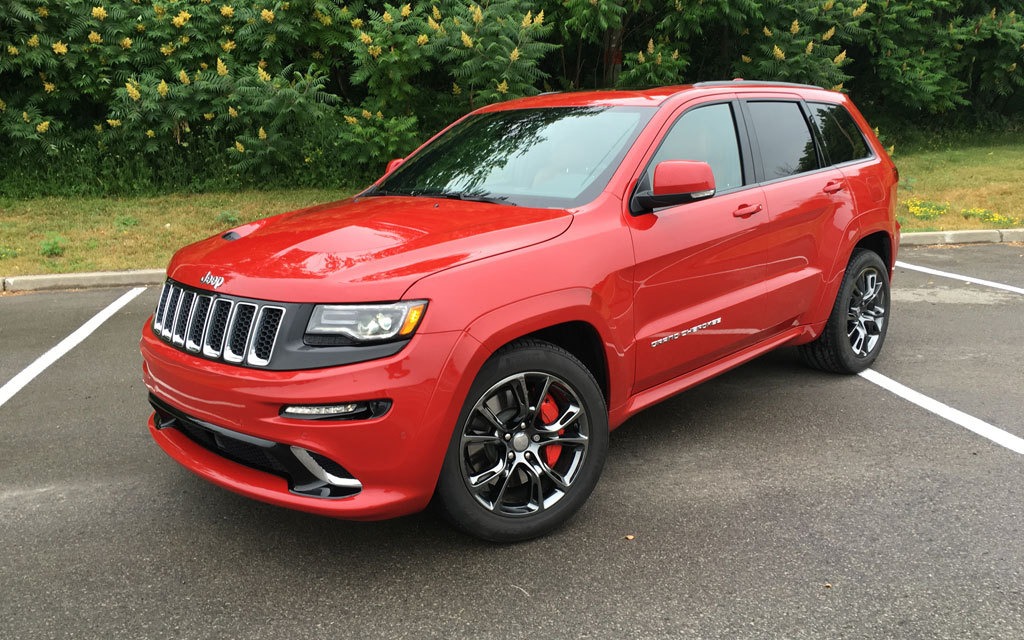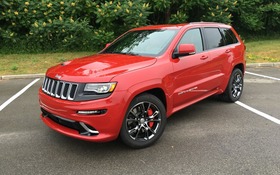2016 Jeep Grand Cherokee SRT: a Wolf in Jeep’s Clothing

| Strong points |
|
|---|---|
| Weak points |
|
If one were to play a word association game and the name Jeep came up, one would most likely reply something like “off-road” or “mud” or a similar term. That’s because the Jeep brand has always been known for its off-road capabilities, particularly with its famous Trail Rated badge which is given to vehicles that pass tests in five categories: traction, ground clearance, manoeuvrability, articulation and water fording.
However, a handful of enthusiasts might have associated the name Jeep with “speed’ and they would be correct! Jeep began offering a high-performance version of the Grand Cherokee in 2006 with the SRT8 (Street and Racing Technology). Jeep was a trailblazer at the time and the vehicle was among the fastest SUVs on the market with 420 horses screaming from the 6.1-litre HEMI V8 under the hood.
- Also: Here is the 2017 Jeep Grand Cherokee Trailhawk
- Also: 2017 Jeep Grand Cherokee Trailhawk gets diesel option
Fast forward to 2016 and the Grand Cherokee SRT has some stiff competition from the likes of BMW (X5 M), Mercedes-Benz (AMG GLE 63), Porsche (Cayenne Turbo) and Land Rover (Range Rover Sport SVR). This year’s Grand Cherokee SRT is powered by a 475-hp HEMI V8, yet has the least amount of power out of the aforementioned vehicles. While the European heavy-hitters have all upped their game in the ultra-fast SUV department, other competitors like GM and Ford have steered clear. Perhaps one day we’ll see a Ford Explorer SVT or Chevy Traverse SS, but not right now.

The 6.4-litre HEMI V8 does a remarkable job of propelling the Grand Cherokee to 100 km/h in just 4.8 seconds. Whether you’re entering the highway and need to get up to speed quickly, or are already cruising along and need a boost to pass another vehicle, the power is ready and waiting—almost itching—to be used. Jeep makes putting that power to the ground easy by way of an eight-speed automatic transmission, complete with steering wheel-mounted paddle shifters.
Jeep adds plenty of other performance goodies such as an electronically controlled limited-slip differential, a launch control system (for those visits to the drag strip), a Bilstein active damping sport suspension and a high-speed engine controller. That last item allows the Jeep to reach a top speed of 257 kilometres per hour. Stopping power comes from Brembo brakes with six- and four-piston callipers, and my test vehicle had the $995 20x10” carbon black forged wheels wrapped in 295/45R20 Pirelli P Zero high-performance tires.
The whole package provides the vehicle with an insane amount of fun potential. To fully explore the 2016 Jeep Grand Cherokee SRT’s performance to its fullest means doing it on a race track or closed circuit, as public roads are definitely not the place for this. I didn’t have the opportunity to get track time, but that being said, there is still plenty of legal exhilaration that can be had off track.
The interior was one of the nicest and most comfortable I’ve tested this year. The luxurious nappa leather seats fill the cabin with a rich aroma as good as any premium brand’s. Leather extends to other parts of the interior such as the armrest, door sills and dash, eliminating any hard plastic surfaces which have plagued Jeeps in the past. Carbon fibre inserts and brushed aluminum round out the finishing. The big, thick, flat-bottom SRT steering wheel is also perfectly done – the importance of which cannot be understated. The contact surfaces of a vehicle (wheel, seats) are critical in connecting with the occupants to provide the best experience possible.

Ergonomically, the Jeep excels in most areas. Buttons and big, easy to use and well placed, which should be a given in 2016, but is hardly the case in many vehicles. What’s lacking is a premium feel on some of the control surfaces. Don’t get me wrong—it’s not poor by any means—but it’s hard to beat the fit and finish of some premium brands. That being said, I find the Jeep beats both of its domestic competitors in this department.
The Cherokee’s class-leading, 8.4-inch touchscreen makes using the Uconnect infotainment system a breeze. Jeep also adds a seven-inch, full colour, customizable in-cluster display directly in front of the driver for the vehicle vitals. Uconnect is among the easiest-to-use infotainment systems available and has many advanced features such as using voice recognition to send text messages, the ability to drag and place on-screen icons and the ability to route incoming calls directly to voicemail.
To distinguish the SRT from the rest of the pack, Jeep makes quite a few subtle modifications to the exterior, including a unique front fascia, blackened trim around the front grille and windows, black headlight and taillight housing and a black rear diffuser. Also notable are the front hood air vents, rear upper spoiler and colour-matched extended rocker panels and fender flares. Though numerous, the modifications are subtle enough that non-Jeep die-hards might not be able to instantly identify the SRT, making it somewhat of a sleeper.
I’ve levelled lots of praise in this article, but is there anything I didn’t like? Well I haven’t got to the price yet. The 2016 Jeep Grand Cherokee SRT starts at $71,695, but add destination, the federal gas-guzzler tax and the air conditioning tax, and you’re looking at $74,590. Available options include the tow group ($795), high performance audio ($1,995), rear DVD screens ($2,150), dual-pane panoramic sunroof ($1,695) and high performance brakes ($1,295).
Add them all and we’re well over $80,000. Spending that amount of money on a Grand Cherokee would irk me a little, especially since the BMW X5 starts at $66,300, the Porsche Cayenne at $68,900, the Range Rover Sport at $75,990. Now these are, of course, base-trim prices and those vehicles wouldn’t be able to tear up the asphalt like the SRT would, but this is a recurring conundrum with high-performance specialty vehicles such as the Volkswagen Golf R or Ford Focus RS.
In the end, if nobody could justify spending the cash then these vehicles wouldn’t exist would they? Let’s be thankful that there are enough performance-crazed buyers willing to shun everything else in the name of performance.











